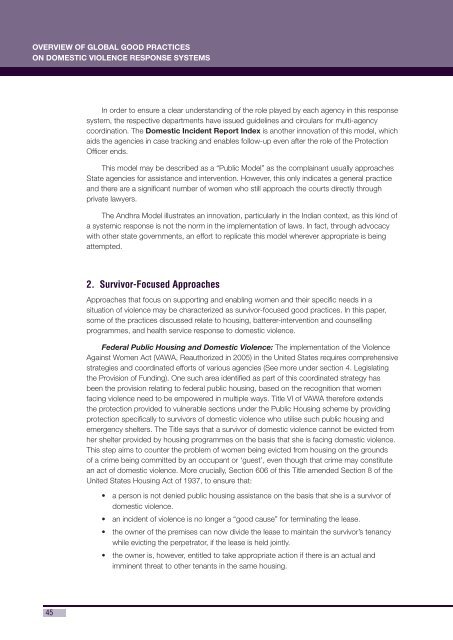Domestic Violence Legislation and its Implementation
Domestic Violence Legislation and its Implementation
Domestic Violence Legislation and its Implementation
You also want an ePaper? Increase the reach of your titles
YUMPU automatically turns print PDFs into web optimized ePapers that Google loves.
OVERVIEW OF GLOBAL GOOD PRACTICES<br />
ON DOMESTIC VIOLENCE RESPONSE SYSTEMS<br />
45<br />
In order to ensure a clear underst<strong>and</strong>ing of the role played by each agency in this response<br />
system, the respective departments have issued guidelines <strong>and</strong> circulars for multi-agency<br />
coordination. The <strong>Domestic</strong> Incident Report Index is another innovation of this model, which<br />
aids the agencies in case tracking <strong>and</strong> enables follow-up even after the role of the Protection<br />
Offi cer ends.<br />
This model may be described as a “Public Model” as the complainant usually approaches<br />
State agencies for assistance <strong>and</strong> intervention. However, this only indicates a general practice<br />
<strong>and</strong> there are a signifi cant number of women who still approach the courts directly through<br />
private lawyers.<br />
The Andhra Model illustrates an innovation, particularly in the Indian context, as this kind of<br />
a systemic response is not the norm in the implementation of laws. In fact, through advocacy<br />
with other state governments, an effort to replicate this model wherever appropriate is being<br />
attempted.<br />
2. Survivor-Focused Approaches<br />
Approaches that focus on supporting <strong>and</strong> enabling women <strong>and</strong> their specifi c needs in a<br />
situation of violence may be characterized as survivor-focused good practices. In this paper,<br />
some of the practices discussed relate to housing, batterer-intervention <strong>and</strong> counselling<br />
programmes, <strong>and</strong> health service response to domestic violence.<br />
Federal Public Housing <strong>and</strong> <strong>Domestic</strong> <strong>Violence</strong>: The implementation of the <strong>Violence</strong><br />
Against Women Act (VAWA, Reauthorized in 2005) in the United States requires comprehensive<br />
strategies <strong>and</strong> coordinated efforts of various agencies (See more under section 4. Legislating<br />
the Provision of Funding). One such area identifi ed as part of this coordinated strategy has<br />
been the provision relating to federal public housing, based on the recognition that women<br />
facing violence need to be empowered in multiple ways. Title VI of VAWA therefore extends<br />
the protection provided to vulnerable sections under the Public Housing scheme by providing<br />
protection specifi cally to survivors of domestic violence who utilise such public housing <strong>and</strong><br />
emergency shelters. The Title says that a survivor of domestic violence cannot be evicted from<br />
her shelter provided by housing programmes on the basis that she is facing domestic violence.<br />
This step aims to counter the problem of women being evicted from housing on the grounds<br />
of a crime being committed by an occupant or ‘guest’, even though that crime may constitute<br />
an act of domestic violence. More crucially, Section 606 of this Title amended Section 8 of the<br />
United States Housing Act of 1937, to ensure that:<br />
• a person is not denied public housing assistance on the basis that she is a survivor of<br />
domestic violence.<br />
• an incident of violence is no longer a “good cause” for terminating the lease.<br />
• the owner of the premises can now divide the lease to maintain the survivor’s tenancy<br />
while evicting the perpetrator, if the lease is held jointly.<br />
• the owner is, however, entitled to take appropriate action if there is an actual <strong>and</strong><br />
imminent threat to other tenants in the same housing.

















